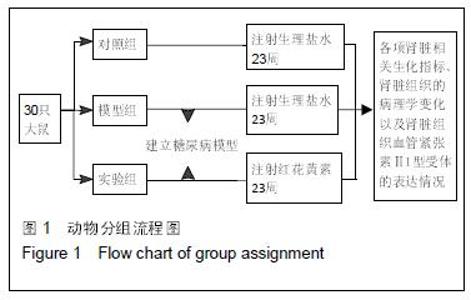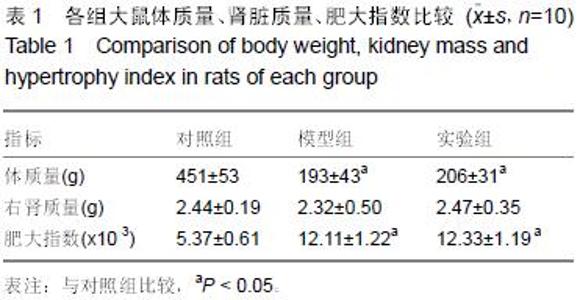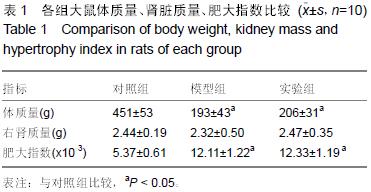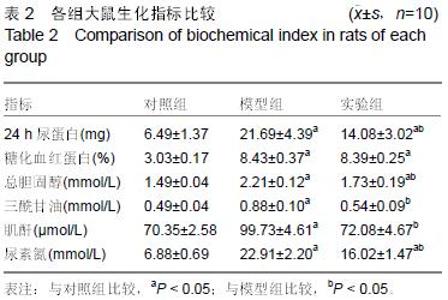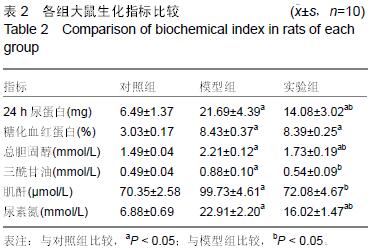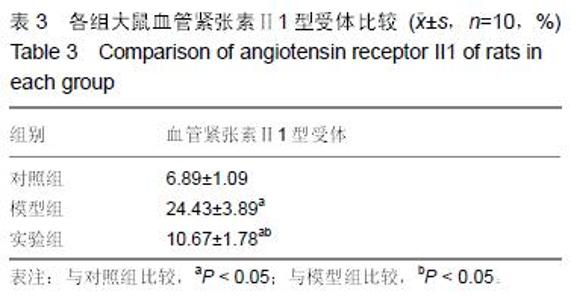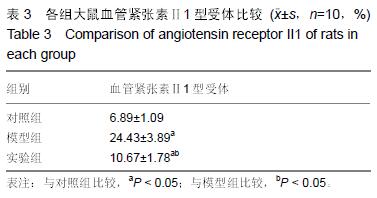Chinese Journal of Tissue Engineering Research ›› 2016, Vol. 20 ›› Issue (18): 2677-2683.doi: 10.3969/j.issn.2095-4344.2016.18.014
Previous Articles Next Articles
Effects of safflower yellow on angiotensin receptor II1 of kidney cells in diabetic nephropathy rats
Gao Yan1, Yuan Lu-liang2, Zhang Hai-song1
- 1Department of Nephrology, Affiliated Hospital of Hebei University, Baoding 071000, Hebei Province, China; 2Health Team of the 66165 Troops of Chinese PLA, Baoding 071000, Hebei Province, China
-
Received:2016-02-07Online:2016-04-29Published:2016-04-29 -
Contact:Zhang Hai-song, Master, Chief physician, Department of Nephrology, Affiliated Hospital of Hebei University, Baoding 071000, Hebei Province, China -
About author:Gao Yan, Master, Associate chief physician, Associate professor, Department of Nephrology, Affiliated Hospital of Hebei University, Baoding 071000, Hebei Province, China -
Supported by:the Tracking Project of Medical Application Technology in Hebei Province, No. GL201311
Cite this article
Gao Yan, Yuan Lu-liang, Zhang Hai-song. Effects of safflower yellow on angiotensin receptor II1 of kidney cells in diabetic nephropathy rats [J]. Chinese Journal of Tissue Engineering Research, 2016, 20(18): 2677-2683.
share this article
|
[1] Hotta N, Kawamori R, Fukuda M, et al. Short Report: TreatmentLong-term clinical effects of epalrestat, an aldose reductase inhibitor, on progression of diabetic neuropathy and other microvascular complications: multivariate epidemiological analysis based on patient background factors and severity of diabetic neuropathy. Diabet Med. 2012;29 (12):1529-1533. [2] 苏彦君,郝存勖,王青菊,等.姜黄素对实验性糖尿病大鼠肾脏蛋白激酶C移位活化的抑制作用[J].河北医药, 2010, 32(24): 3434-3436. [3] Shepler B,Nash C,Smith C,et al.Update on Potential Drugs for the Treatment of Diabetic Kidney Disease. Clin Ther. 2012;34(6):1237-1246. [4] Zhou X, Wang B, Zhu L, et al. A novel improved therapy strategy for diabetic nephropathy:Targeting AGEs. Organogenesis.2012;8(1):18-21. [5] 丁瑞恒,廖蕴华. 黄芪对晚期糖基化终末产物作用下肾小球系膜细胞的影响[J].江苏中医药.2011,43(3):82-84. [6] 余伍中,高国胜,翁光明.黄芪注射液对早期糖尿病肾病肾功能指标的影响[J].浙江临床医学.2012,14(12):1508- 1509. [7] 施海涛,王雪峰,董春玲,等.冬虫夏草制剂治疗糖尿病肾病的作用机制研究进展[J].健康必读.2011,(9):332-332. [8] 施海涛,杨庆春,王雪峰,等.冬虫夏草对延缓糖尿病肾病肾小球系膜细胞增殖的研究[J].中国现代医生.2011,49(22): 11-12. [9] 张煜敏,杨丽萍,沈波.金水宝胶囊治疗糖尿病肾病的系统评价[J].现代中西医结合杂志.2012,21(23):2509-2512. [10] 陈艳,吴晨光,王丽,等.α-硫辛酸对糖尿病大鼠肾脏聚 ADP-核糖多聚酶表达的影响[J].江苏医药,2011,37(6): 624-626. [11] Yi X, Xu L, Hiller S, et al. Reduced expression of lipoic acid synthase accelerates diabetic nephropathy.J Am Soc Nephrol. 2012;23(1): 103-111. [12] 李雪峰,李艳颖,贾文红,等.a-硫辛酸治疗43例Ⅲ期糖尿病肾病患者疗效分析[J].中国慢性病预防与控制, 2011, 19(5): 506-508. [13] Hwang I,Lee J, Huh JY, et al. Catalase deficiency accelerates diabetic renal injury through peroxisomal dysfunction. Diabetes. 2012;61(3):728-738. [14] Zhang Y, Peng F,Gao B,et al.High glucose-induced RhoA activation requires caveolae and PKCβ1-mediated ROS generation.Am J Physiol Renal Physiol.2012;302(1): F159-172. [15] 王雅芸,徐家蓉,缪珩,等.白藜芦醇对糖尿病大鼠肾皮质氧化应激损伤的保护作用[J].中华糖尿病杂志,2012,4(4): 229-233. [16] 田华生,宋丹玲.尿毒清颗粒治疗糖尿病肾病肾功能不全的疗效观察[J].临床内科杂志,2011,28(5):350-351. [17] 李群苑,毛林浩.糖尿病肾病患者的临床分析[J].当代医学,2011,17(23):49-50. [18] 刘会贞,刘雯,李金荣,等.RAS 双重阻断治疗糖尿病肾病患者的疗效[J].中国老年学杂志,2011,31(11):1964-1966 [19] Banki NF,Ver A,WagnerLJ,et al.Aldosterone Antagonists in Monotherapy Are Protective against Streptozotocin-Induced Diabetic Nephropathy in Rats.PLoS One. 2012;7 (6): e39938. [20] 李世云,李勤,李黎,等.螺内酯对 2 型糖尿病肾病患者尿清蛋白的影响[J].中国全科医学,2011,14(33):3784- 3786. [21] 刘小娟,杨藕罗,冯辉亮.厄贝沙坦联合螺内酯治疗糖尿病肾病微量蛋白尿的临床疗效观察[J].中国医药指南,2012, 10(2):25-26. [22] 梁国瑞,刘俊霞.贝那普利和螺内酯联合治疗糖尿病肾病的临床研究[J].中国医药科.2012,2(2):99-99. [23] 马东蔚,王秋月. Rho/Rho激酶信号通路与糖尿病肾病[J].国际内分泌代谢杂志,2011,31(3):193-195. [24] 王丹,施辉范,亚平,等.螺内酯对 ROCK1 在单肾切除糖尿病大鼠肾组织中表达及活性的影响[J].中华肾脏病杂志,2012,28(7): 512-517. [25] 王洋.TSC-mTOR 信号通路在糖尿病及糖尿病肾病发病机制中的作用[J].广西医学,2010,32(3):354-358 [26] Zhang S,Cai G,Fu B,et al.SIRT1 is required for the effects of rapamycin on high glucose-inducing mesangial cells senescence. Mech Ageing Dev. 2012;133 (6): 387-400. [27] 刘磊,常保超,郝丽.霉酚酸酯对糖尿病大鼠肾组织中TGF-β1 与 OPN 表达的影响[J].中华全科医学, 2011, 9(5):676-677. [28] YU WM,WANG H,REN XJ,et al. Experimental study of leflunomide on renal Protective effect and on inflammatory response of streptozotocin induced diabetic rats.Nephrology (Carlton).2012;17(4): 380-389. [29] 李洁,张乾坤,金烈.糖尿病肾病大鼠足细胞的影响[J].浙江实用 医学.2012,17(1):10-12. [30] 宋纯东,薛黎明.雷公藤多甙对早期糖尿病肾病大鼠肾组织 TGF-β1表达的影响[J].中国中医药科技,2011, 18(2): 125-126. [31] 辛小龙,王静.不同剂量雷公藤多甙治疗糖尿病肾病的短期疗效差异[J]. 现代中西医结合杂志.2011,20(30): 3815-3816. [32] 中国医师协会内分泌代谢科医师分会.2 型糖尿病合并慢性肾脏病患者口服降糖药用药原则中国专家共识[J].中国糖尿病杂志,2013,21(10):865-870. [33] 叶俊鹏,黄培良,赖瑞平. 门诊常用降脂药物的用药分析[J].现代医院2013,13(12):65-67. [34] 金秀名. 血液透析与腹膜透析治疗糖尿病肾病的疗效观察[J].中国实用医药,2014,9(1):118-119. [35] 陆翰澜,陈瑜,傅尚希,等. 亲属活体肾移植后供者安全性评价[J].中国组织工程研究,2013,17(44):7681-7686. [36] 李建国,胡齐鸣,张宝霞,等.益气养阴收敛固涩方治疗气阴两虚型糖尿病肾病30例临床观察[J].实用中西医结合临床,2014,14(3):77-78 [37] 郭彦军.益肾化瘀方治疗糖尿病肾病疗效观察[J].陕西中医,2013,34(8):954-955. [38] 蒋丙义. 血府逐瘀汤治疗43例糖尿病肾病临床效果观察[J].基础医学论坛,2014,18(14):1854-1855. [39] 万秋,刘秀明,杨文婷.红花黄色素研究概述[J].生命的化学, 2013,33(2):54-58. [40] 刘俐,魏云,卜振军,等.红花黄色素对犬心肌缺血及血流动力学的影响[J].中国医药科学,2013,24:26-28. [41] 郭雪婷,杨晓君,王颖.复合红花黄色素抗凝血作用研究[J].新疆农业科学,2012,49(9):1759-1763. [42] 苏慧,刘萍,温薇,等.红花黄色素冻干粉针对大鼠体内体外血栓形成的影响[J].中医药信息,2012,29(6):29-30. [43] 韩进庭.红花黄色素在髋关节置换术后预防下肢静脉血栓中的应用[J].中国实用医药,2013,8(26):192-193. [44] 薛新宏,赵小明,彭延波,等.雌激素联合依达拉奉对大鼠脑缺血再灌注的神经保护作用[J].河北医药,2013,35(3): 325-327. [45] 王晓丽,王毅,张赛,等.红花黄色素对大鼠脑缺血再灌注损伤的保护作用[J].中华实用诊断与治疗杂志,2014,28(1): 12-14. [46] Zhang N,Xing MY,Wang YY,et al.Hydroxysaf ower yellow A improves learning and memory in a rat model of vascular dementia by increasing VEGF and NR1 in the hippocampus.Neurosci Bull.2014;30(3):417-424. [47] 胡波,裴昌录,李小川.注射用红花黄色素对股骨折患者炎症因子影响探讨[J].辽宁中医药大学学报,2013,15(8): 201-203. [48] 白雪梅,李向东,宋洁,等. 红花黄色素对早期糖尿病肾病患者hs-CRP、IL-8的影响[J].中国中西医结合肾病杂志, 2012,13(8):698-700. [49] 郭登洲,王月华,边东,等.红花黄色素对糖尿病肾病大鼠血管紧张素系统的影响[J].中成药,2009,31(12): 1832-1836.
|
| [1] | Zhang Tongtong, Wang Zhonghua, Wen Jie, Song Yuxin, Liu Lin. Application of three-dimensional printing model in surgical resection and reconstruction of cervical tumor [J]. Chinese Journal of Tissue Engineering Research, 2021, 25(9): 1335-1339. |
| [2] | Zeng Yanhua, Hao Yanlei. In vitro culture and purification of Schwann cells: a systematic review [J]. Chinese Journal of Tissue Engineering Research, 2021, 25(7): 1135-1141. |
| [3] | Xu Dongzi, Zhang Ting, Ouyang Zhaolian. The global competitive situation of cardiac tissue engineering based on patent analysis [J]. Chinese Journal of Tissue Engineering Research, 2021, 25(5): 807-812. |
| [4] | Wu Zijian, Hu Zhaoduan, Xie Youqiong, Wang Feng, Li Jia, Li Bocun, Cai Guowei, Peng Rui. Three-dimensional printing technology and bone tissue engineering research: literature metrology and visual analysis of research hotspots [J]. Chinese Journal of Tissue Engineering Research, 2021, 25(4): 564-569. |
| [5] | Chang Wenliao, Zhao Jie, Sun Xiaoliang, Wang Kun, Wu Guofeng, Zhou Jian, Li Shuxiang, Sun Han. Material selection, theoretical design and biomimetic function of artificial periosteum [J]. Chinese Journal of Tissue Engineering Research, 2021, 25(4): 600-606. |
| [6] | Liu Fei, Cui Yutao, Liu He. Advantages and problems of local antibiotic delivery system in the treatment of osteomyelitis [J]. Chinese Journal of Tissue Engineering Research, 2021, 25(4): 614-620. |
| [7] | Li Xiaozhuang, Duan Hao, Wang Weizhou, Tang Zhihong, Wang Yanghao, He Fei. Application of bone tissue engineering materials in the treatment of bone defect diseases in vivo [J]. Chinese Journal of Tissue Engineering Research, 2021, 25(4): 626-631. |
| [8] | Zhang Zhenkun, Li Zhe, Li Ya, Wang Yingying, Wang Yaping, Zhou Xinkui, Ma Shanshan, Guan Fangxia. Application of alginate based hydrogels/dressings in wound healing: sustained, dynamic and sequential release [J]. Chinese Journal of Tissue Engineering Research, 2021, 25(4): 638-643. |
| [9] | Chen Jiana, Qiu Yanling, Nie Minhai, Liu Xuqian. Tissue engineering scaffolds in repairing oral and maxillofacial soft tissue defects [J]. Chinese Journal of Tissue Engineering Research, 2021, 25(4): 644-650. |
| [10] | Xing Hao, Zhang Yonghong, Wang Dong. Advantages and disadvantages of repairing large-segment bone defect [J]. Chinese Journal of Tissue Engineering Research, 2021, 25(3): 426-430. |
| [11] | Chen Siqi, Xian Debin, Xu Rongsheng, Qin Zhongjie, Zhang Lei, Xia Delin. Effects of bone marrow mesenchymal stem cells and human umbilical vein endothelial cells combined with hydroxyapatite-tricalcium phosphate scaffolds on early angiogenesis in skull defect repair in rats [J]. Chinese Journal of Tissue Engineering Research, 2021, 25(22): 3458-3465. |
| [12] | Wang Hao, Chen Mingxue, Li Junkang, Luo Xujiang, Peng Liqing, Li Huo, Huang Bo, Tian Guangzhao, Liu Shuyun, Sui Xiang, Huang Jingxiang, Guo Quanyi, Lu Xiaobo. Decellularized porcine skin matrix for tissue-engineered meniscus scaffold [J]. Chinese Journal of Tissue Engineering Research, 2021, 25(22): 3473-3478. |
| [13] | Mo Jianling, He Shaoru, Feng Bowen, Jian Minqiao, Zhang Xiaohui, Liu Caisheng, Liang Yijing, Liu Yumei, Chen Liang, Zhou Haiyu, Liu Yanhui. Forming prevascularized cell sheets and the expression of angiogenesis-related factors [J]. Chinese Journal of Tissue Engineering Research, 2021, 25(22): 3479-3486. |
| [14] | Liu Chang, Li Datong, Liu Yuan, Kong Lingbo, Guo Rui, Yang Lixue, Hao Dingjun, He Baorong. Poor efficacy after vertebral augmentation surgery of acute symptomatic thoracolumbar osteoporotic compression fracture: relationship with bone cement, bone mineral density, and adjacent fractures [J]. Chinese Journal of Tissue Engineering Research, 2021, 25(22): 3510-3516. |
| [15] | Liu Liyong, Zhou Lei. Research and development status and development trend of hydrogel in tissue engineering based on patent information [J]. Chinese Journal of Tissue Engineering Research, 2021, 25(22): 3527-3533. |
| Viewed | ||||||
|
Full text |
|
|||||
|
Abstract |
|
|||||
